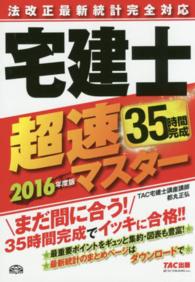- ホーム
- > 洋書
- > 英文書
- > Religion / Ethics
Full Description
Facing issues of violence and conflict, authors of textbooks for Religious Education (RE) choose a range of different strategies. While some try to write as non-controversially as possible about such issues, other authors choose to leave them completely out. Even in the academic study of religions, a well-established perspective is that religion is primarily something good, and important for societies as well as for human development. Such basic presumptions/perspectives are often nurtured by an apologetic orientation to the representation of religion. In some cases, religious violence and conflict are therefore considered disruptive forces that destroy what is "true," "authentic" and "valuable" in religion.Textbook Violence offers critical perspectives on how textbooks deal or not deal with issues of conflict and violence in religions. The volume's contributions provide examples from textbooks for university level as well as from RE in schools, and include discussions of conflict and violence in a range of different religious traditions.
The contributors bring issues of religious violence and conflict into focus through such questions as: In what way is violence and/or conflict treated? Who are the authorial voices? What are their aims? Who is the reader being addressed? How are the representations of religions framed by value judgments?Beyond certain obvious ideological considerations (e.g., nationalism; the interests of religious pedagogues who contribute to textbooks in some countries), there are a number of different factors shaping representations of religions in textbooks - from commercial considerations and statutory stipulations to situations where publishers and national examination boards work closely together to produce textbooks with contents keyed to national exams. This means that authors have to face different expectations and considerations when writing textbooks. Textbook Violence will also include reflections on the choices such authors are facing.
Contents
IntroductionJames R. Lewis and Bengt-Ove Andreassen1. Reading Beyond the Lines: What Students Learn From their History TextbooksMichael H. Romanowski, Qatar University2. This is not a Religion!: "The Treachery of the Iages" of Aum, Yasukuni and Al-Qaeda in Japanese TextbooksSatoko Fujiwara, University of Tokyo3. Ignore the War, Concentrate on Peace: Textbook Analysis of Strategies in Post-Conflict Societies - A Praxeological ApproachZrinka Stimac, Georg Eckert Institute, Germany4. Colonial Conflicts: Absence, Inclusion and Indigenization in Textbook Presentations of Indigenous Peoples Torjer A. Olsen, University of Tromso5. Talking about Conflicts in Pursuit of the Common Good, or how to Handle Sensitive Topics while Learning about Religions: The Approach of the Ethics and Religious Culture Textbooks in Quebec Sivane Hirsch, Universite du Quebec a Trois- Rivieres6. Representations of Anti-Semitism and the Holocaust in RE Textbooks for Norwegian Upper Secondary SchoolSuzanne Anett Thobro, University of Tromso7. Aniconism and Images in Norwegian RE Textbooks: Representations and Historical ChangeSissel Undheim, University of Bergen8. Undermining Authority: The Representation of Buddhism and Discourse on Modernity in Religion Education TextbooksKai Arne Nyborg, University of Tromso 9. Significant or Insignificant Absence? Religion and Violence in RE Textbooks for Norwegian Teacher EducationBengt-Ove Andreassen10. Toward an Appreciation of Non-NormativityA Quasi-AutobiographyAaron W. Hughes, University of Rochester11. Self-Contradictions and Projected Otherness: Images of Sikh Militancy in the Writings of Orientalist Scholars and Contemporary Textbook AuthorsJames R. Lewis







